Rémi Bardenet
Filtering through a topological lens: homology for point processes on the time-frequency plane
Apr 10, 2025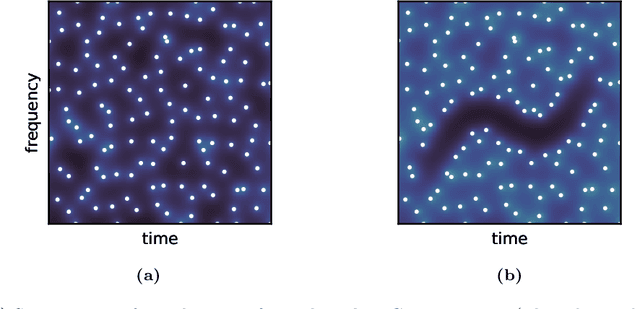
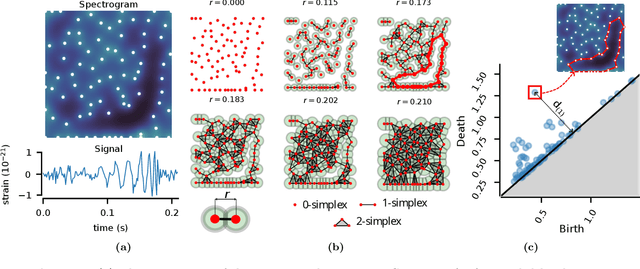
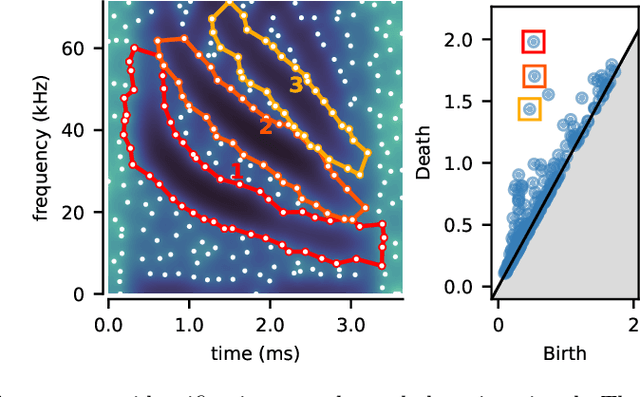
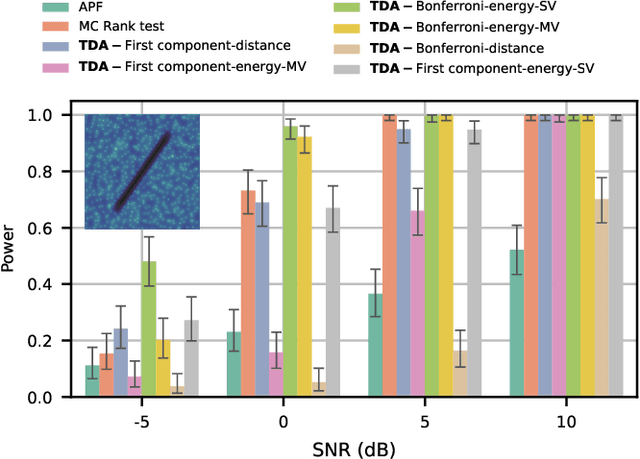
Abstract:We introduce a very general approach to the analysis of signals from their noisy measurements from the perspective of Topological Data Analysis (TDA). While TDA has emerged as a powerful analytical tool for data with pronounced topological structures, here we demonstrate its applicability for general problems of signal processing, without any a-priori geometric feature. Our methods are well-suited to a wide array of time-dependent signals in different scientific domains, with acoustic signals being a particularly important application. We invoke time-frequency representations of such signals, focusing on their zeros which are gaining salience as a signal processing tool in view of their stability properties. Leveraging state-of-the-art topological concepts, such as stable and minimal volumes, we develop a complete suite of TDA-based methods to explore the delicate stochastic geometry of these zeros, capturing signals based on the disruption they cause to this rigid, hyperuniform spatial structure. Unlike classical spatial data tools, TDA is able to capture the full spectrum of the stochastic geometry of the zeros, thereby leading to powerful inferential outcomes that are underpinned by a principled statistical foundation. This is reflected in the power and versatility of our applications, which include competitive performance in processing. a wide variety of audio signals (esp. in low SNR regimes), effective detection and reconstruction of gravitational wave signals (a reputed signal processing challenge with non-Gaussian noise), and medical time series data from EEGs, indicating a wide horizon for the approach and methods introduced in this paper.
Bypassing orthogonalization in the quantum DPP sampler
Mar 07, 2025



Abstract:Given an $n\times r$ matrix $X$ of rank $r$, consider the problem of sampling $r$ integers $\mathtt{C}\subset \{1, \dots, n\}$ with probability proportional to the squared determinant of the rows of $X$ indexed by $\mathtt{C}$. The distribution of $\mathtt{C}$ is called a projection determinantal point process (DPP). The vanilla classical algorithm to sample a DPP works in two steps, an orthogonalization in $\mathcal{O}(nr^2)$ and a sampling step of the same cost. The bottleneck of recent quantum approaches to DPP sampling remains that preliminary orthogonalization step. For instance, (Kerenidis and Prakash, 2022) proposed an algorithm with the same $\mathcal{O}(nr^2)$ orthogonalization, followed by a $\mathcal{O}(nr)$ classical step to find the gates in a quantum circuit. The classical $\mathcal{O}(nr^2)$ orthogonalization thus still dominates the cost. Our first contribution is to reduce preprocessing to normalizing the columns of $X$, obtaining $\mathsf{X}$ in $\mathcal{O}(nr)$ classical operations. We show that a simple circuit inspired by the formalism of Kerenidis et al., 2022 samples a DPP of a type we had never encountered in applications, which is different from our target DPP. Plugging this circuit into a rejection sampling routine, we recover our target DPP after an expected $1/\det \mathsf{X}^\top\mathsf{X} = 1/a$ preparations of the quantum circuit. Using amplitude amplification, our second contribution is to boost the acceptance probability from $a$ to $1-a$ at the price of a circuit depth of $\mathcal{O}(r\log n/\sqrt{a})$ and $\mathcal{O}(\log n)$ extra qubits. Prepending a fast, sketching-based classical approximation of $a$, we obtain a pipeline to sample a projection DPP on a quantum computer, where the former $\mathcal{O}(nr^2)$ preprocessing bottleneck has been replaced by the $\mathcal{O}(nr)$ cost of normalizing the columns and the cost of our approximation of $a$.
Small coresets via negative dependence: DPPs, linear statistics, and concentration
Nov 01, 2024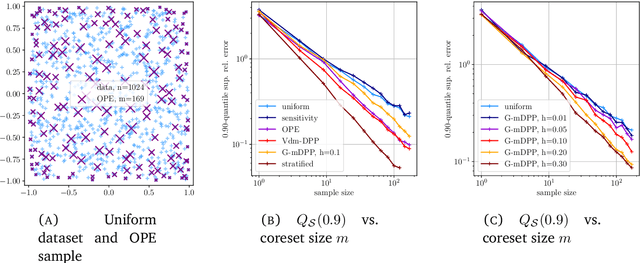
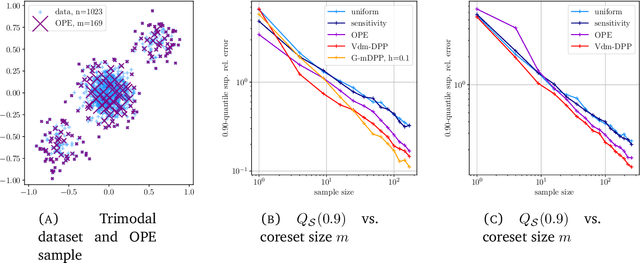
Abstract:Determinantal point processes (DPPs) are random configurations of points with tunable negative dependence. Because sampling is tractable, DPPs are natural candidates for subsampling tasks, such as minibatch selection or coreset construction. A \emph{coreset} is a subset of a (large) training set, such that minimizing an empirical loss averaged over the coreset is a controlled replacement for the intractable minimization of the original empirical loss. Typically, the control takes the form of a guarantee that the average loss over the coreset approximates the total loss uniformly across the parameter space. Recent work has provided significant empirical support in favor of using DPPs to build randomized coresets, coupled with interesting theoretical results that are suggestive but leave some key questions unanswered. In particular, the central question of whether the cardinality of a DPP-based coreset is fundamentally smaller than one based on independent sampling remained open. In this paper, we answer this question in the affirmative, demonstrating that \emph{DPPs can provably outperform independently drawn coresets}. In this vein, we contribute a conceptual understanding of coreset loss as a \emph{linear statistic} of the (random) coreset. We leverage this structural observation to connect the coresets problem to a more general problem of concentration phenomena for linear statistics of DPPs, wherein we obtain \emph{effective concentration inequalities that extend well-beyond the state-of-the-art}, encompassing general non-projection, even non-symmetric kernels. The latter have been recently shown to be of interest in machine learning beyond coresets, but come with a limited theoretical toolbox, to the extension of which our result contributes. Finally, we are also able to address the coresets problem for vector-valued objective functions, a novelty in the coresets literature.
Point Processes and spatial statistics in time-frequency analysis
Feb 29, 2024



Abstract:A finite-energy signal is represented by a square-integrable, complex-valued function $t\mapsto s(t)$ of a real variable $t$, interpreted as time. Similarly, a noisy signal is represented by a random process. Time-frequency analysis, a subfield of signal processing, amounts to describing the temporal evolution of the frequency content of a signal. Loosely speaking, if $s$ is the audio recording of a musical piece, time-frequency analysis somehow consists in writing the musical score of the piece. Mathematically, the operation is performed through a transform $\mathcal{V}$, mapping $s \in L^2(\mathbb{R})$ onto a complex-valued function $\mathcal{V}s \in L^2(\mathbb{R}^2)$ of time $t$ and angular frequency $\omega$. The squared modulus $(t, \omega) \mapsto \vert\mathcal{V}s(t,\omega)\vert^2$ of the time-frequency representation is known as the spectrogram of $s$; in the musical score analogy, a peaked spectrogram at $(t_0,\omega_0)$ corresponds to a musical note at angular frequency $\omega_0$ localized at time $t_0$. More generally, the intuition is that upper level sets of the spectrogram contain relevant information about in the original signal. Hence, many signal processing algorithms revolve around identifying maxima of the spectrogram. In contrast, zeros of the spectrogram indicate perfect silence, that is, a time at which a particular frequency is absent. Assimilating $\mathbb{R}^2$ to $\mathbb{C}$ through $z = \omega + \mathrm{i}t$, this chapter focuses on time-frequency transforms $\mathcal{V}$ that map signals to analytic functions. The zeros of the spectrogram of a noisy signal are then the zeros of a random analytic function, hence forming a Point Process in $\mathbb{C}$. This chapter is devoted to the study of these Point Processes, to their links with zeros of Gaussian Analytic Functions, and to designing signal detection and denoising algorithms using spatial statistics.
Monte Carlo with kernel-based Gibbs measures: Guarantees for probabilistic herding
Feb 18, 2024

Abstract:Kernel herding belongs to a family of deterministic quadratures that seek to minimize the worst-case integration error over a reproducing kernel Hilbert space (RKHS). In spite of strong experimental support, it has revealed difficult to prove that this worst-case error decreases at a faster rate than the standard square root of the number of quadrature nodes, at least in the usual case where the RKHS is infinite-dimensional. In this theoretical paper, we study a joint probability distribution over quadrature nodes, whose support tends to minimize the same worst-case error as kernel herding. We prove that it does outperform i.i.d. Monte Carlo, in the sense of coming with a tighter concentration inequality on the worst-case integration error. While not improving the rate yet, this demonstrates that the mathematical tools of the study of Gibbs measures can help understand to what extent kernel herding and its variants improve on computationally cheaper methods. Moreover, we provide early experimental evidence that a faster rate of convergence, though not worst-case, is likely.
Benchmarking multi-component signal processing methods in the time-frequency plane
Feb 13, 2024

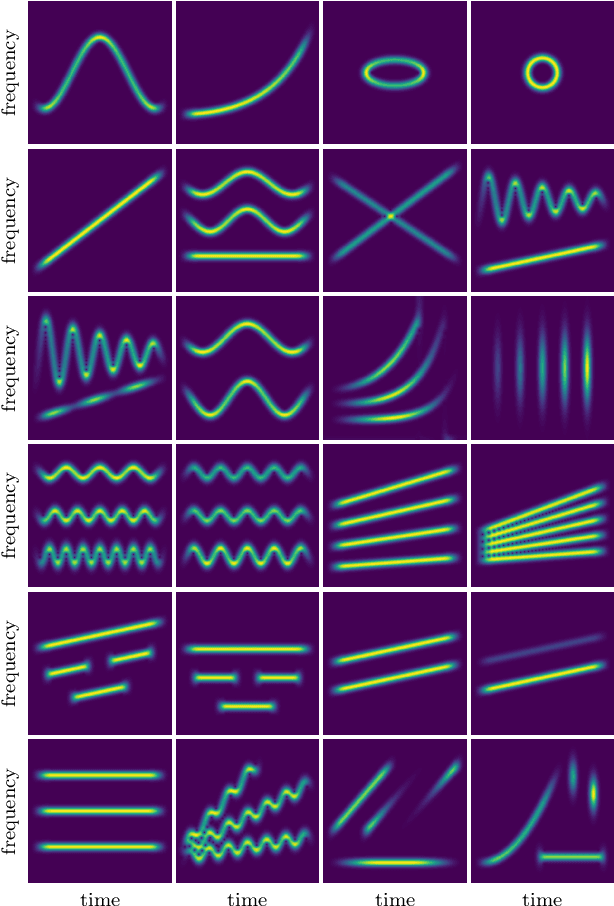

Abstract:Signal processing in the time-frequency plane has a long history and remains a field of methodological innovation. For instance, detection and denoising based on the zeros of the spectrogram have been proposed since 2015, contrasting with a long history of focusing on larger values of the spectrogram. Yet, unlike neighboring fields like optimization and machine learning, time-frequency signal processing lacks widely-adopted benchmarking tools. In this work, we contribute an open-source, Python-based toolbox termed MCSM-Benchs for benchmarking multi-component signal analysis methods, and we demonstrate our toolbox on three time-frequency benchmarks. First, we compare different methods for signal detection based on the zeros of the spectrogram, including unexplored variations of previously proposed detection tests. Second, we compare zero-based denoising methods to both classical and novel methods based on large values and ridges of the spectrogram. Finally, we compare the denoising performance of these methods against typical spectrogram thresholding strategies, in terms of post-processing artifacts commonly referred to as musical noise. At a low level, the obtained results provide new insight on the assessed approaches, and in particular research directions to further develop zero-based methods. At a higher level, our benchmarks exemplify the benefits of using a public, collaborative, common framework for benchmarking.
Signal reconstruction using determinantal sampling
Oct 13, 2023Abstract:We study the approximation of a square-integrable function from a finite number of evaluations on a random set of nodes according to a well-chosen distribution. This is particularly relevant when the function is assumed to belong to a reproducing kernel Hilbert space (RKHS). This work proposes to combine several natural finite-dimensional approximations based two possible probability distributions of nodes. These distributions are related to determinantal point processes, and use the kernel of the RKHS to favor RKHS-adapted regularity in the random design. While previous work on determinantal sampling relied on the RKHS norm, we prove mean-square guarantees in $L^2$ norm. We show that determinantal point processes and mixtures thereof can yield fast convergence rates. Our results also shed light on how the rate changes as more smoothness is assumed, a phenomenon known as superconvergence. Besides, determinantal sampling generalizes i.i.d. sampling from the Christoffel function which is standard in the literature. More importantly, determinantal sampling guarantees the so-called instance optimality property for a smaller number of function evaluations than i.i.d. sampling.
On sampling determinantal and Pfaffian point processes on a quantum computer
May 25, 2023Abstract:DPPs were introduced by Macchi as a model in quantum optics the 1970s. Since then, they have been widely used as models and subsampling tools in statistics and computer science. Most applications require sampling from a DPP, and given their quantum origin, it is natural to wonder whether sampling a DPP on a quantum computer is easier than on a classical one. We focus here on DPPs over a finite state space, which are distributions over the subsets of $\{1,\dots,N\}$ parametrized by an $N\times N$ Hermitian kernel matrix. Vanilla sampling consists in two steps, of respective costs $\mathcal{O}(N^3)$ and $\mathcal{O}(Nr^2)$ operations on a classical computer, where $r$ is the rank of the kernel matrix. A large first part of the current paper consists in explaining why the state-of-the-art in quantum simulation of fermionic systems already yields quantum DPP sampling algorithms. We then modify existing quantum circuits, and discuss their insertion in a full DPP sampling pipeline that starts from practical kernel specifications. The bottom line is that, with $P$ (classical) parallel processors, we can divide the preprocessing cost by $P$ and build a quantum circuit with $\mathcal{O}(Nr)$ gates that sample a given DPP, with depth varying from $\mathcal{O}(N)$ to $\mathcal{O}(r\log N)$ depending on qubit-communication constraints on the target machine. We also connect existing work on the simulation of superconductors to Pfaffian point processes, which generalize DPPs and would be a natural addition to the machine learner's toolbox. Finally, the circuits are empirically validated on a classical simulator and on 5-qubit machines.
From point processes to quantum optics and back
Oct 11, 2022
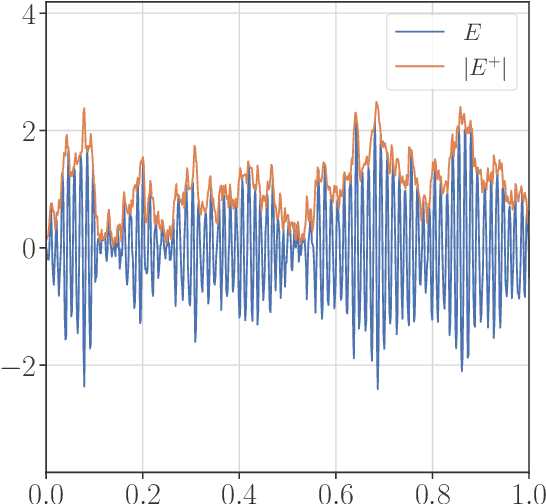
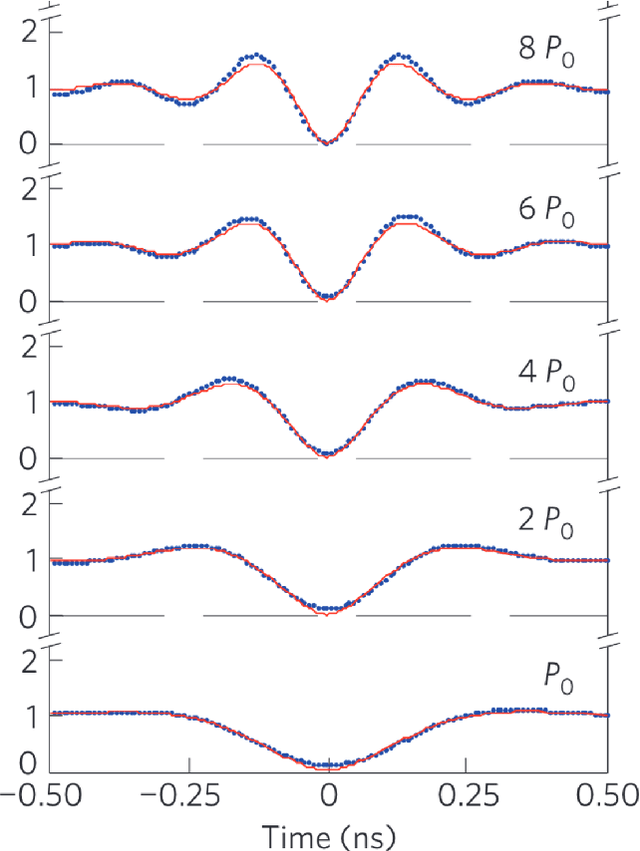

Abstract:Some fifty years ago, in her seminal PhD thesis, Odile Macchi introduced permanental and determinantal point processes. Her initial motivation was to provide models for the set of detection times in fundamental bosonic or fermionic optical experiments, respectively. After two rather quiet decades, these point processes have quickly become standard examples of point processes with nontrivial, yet tractable, correlation structures. In particular, determinantal point processes have been since the 1990s a technical workhorse in random matrix theory and combinatorics, and a standard model for repulsive point patterns in machine learning and spatial statistics since the 2010s. Meanwhile, our ability to experimentally probe the correlations between detection events in bosonic and fermionic optics has progressed tremendously. In Part I of this survey, we provide a modern introduction to the concepts in Macchi's thesis and their physical motivation, under the combined eye of mathematicians, physicists, and signal processers. Our objective is to provide a shared basis of knowledge for later cross-disciplinary work on point processes in quantum optics, and reconnect with the physical roots of permanental and determinantal point processes.
Sparsification of the regularized magnetic Laplacian with multi-type spanning forests
Aug 31, 2022



Abstract:In this paper, we consider a ${\rm U}(1)$-connection graph, that is, a graph where each oriented edge is endowed with a unit modulus complex number which is simply conjugated under orientation flip. A natural replacement for the combinatorial Laplacian is then the so-called magnetic Laplacian, an Hermitian matrix that includes information about the graph's connection. Connection graphs and magnetic Laplacians appear, e.g., in the problem of angular synchronization. In the context of large and dense graphs, we study here sparsifiers of the magnetic Laplacian, i.e., spectral approximations based on subgraphs with few edges. Our approach relies on sampling multi-type spanning forests (MTSFs) using a custom determinantal point process, a distribution over edges that favours diversity. In a word, an MTSF is a spanning subgraph whose connected components are either trees or cycle-rooted trees. The latter partially capture the angular inconsistencies of the connection graph, and thus provide a way to compress information contained in the connection. Interestingly, when this connection graph has weakly inconsistent cycles, samples of this distribution can be obtained by using a random walk with cycle popping. We provide statistical guarantees for a choice of natural estimators of the connection Laplacian, and investigate the practical application of our sparsifiers in two applications.
 Add to Chrome
Add to Chrome Add to Firefox
Add to Firefox Add to Edge
Add to Edge